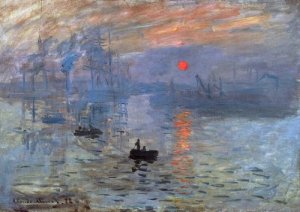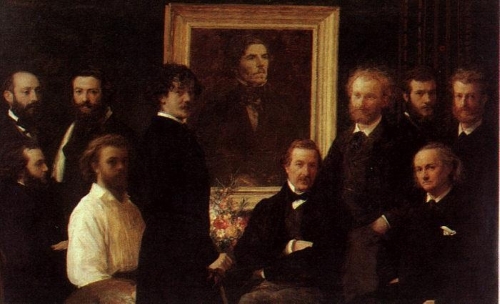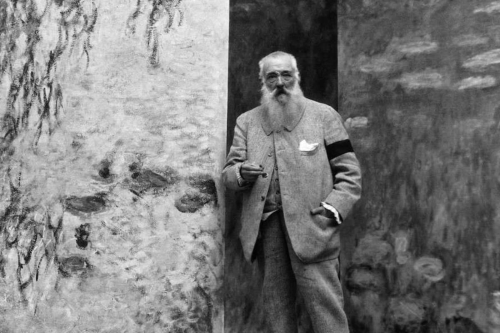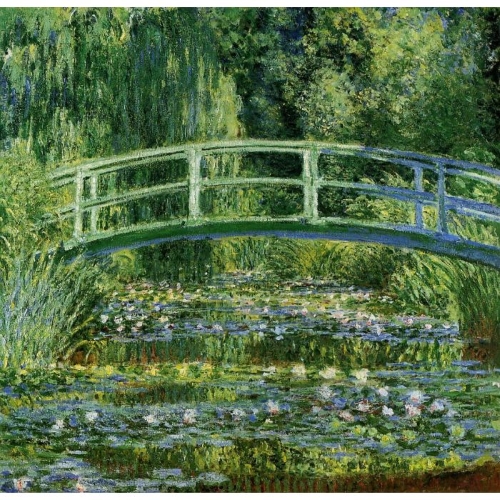Monet: The Master of Impressionism

Oscar-Claude Monet is one of the most famous French painters. He was born on November 14th, 1840, in Paris, France. His family moved to Le Havre when he was five and his father started working as a merchant. His mother, Louise, was a singer.
Le Havre, a coastal city, is where Monet learned a lot about the sea. Impressionism focused on painting and representing nature. Monet’s paintings reflect the ever-changing aspect of light and weather conditions.
Claude Monet’s beginnings in painting
As a 15-year-old, Monet sold cartoons and very detailed pencil sketches of sailboats. His aunt, Marie-Jeanne Lecadre, an amateur painter, greatly influenced the young painter. She encouraged Monet to study art with a local artist.
“Color is my day-long obsession, joy, and torment.”
-Claude Monet-
However, his painting truly evolved when he met Eugène Boudin. Boudin presented Monet with the, at the time, uncommon practice of painting outdoors. Due to this, he spent the next 60 years focused on visible phenomena. Likewise, he implemented effective methods that would transform color perception.
Against his family’s wishes, Monet didn’t attend the École nationale supérieure des Beaux-Arts in Paris. While he worked at the Académie Suisse, he met Camille Pissarro.
After being forced to fight in the Algerian War, he returned to Paris and met Renoir, Cézanne, Whistler, and Manet. During this period, Monet discovered Japanese patterns and this fascination influenced his work.

Young Monet and the Salon des Refusés
In 1870, he married Camille Doncieux. The family moved to London during the Franco-Prussian War. Afterward, they returned to Argenteuil, in Paris.
The term ‘Impressionism’ was coined after his painting Impression, soleil levant (Impression, Sunrise), which was displayed in 1874 in the first independent art exhibition of Impressionist painters.
This art show catapulted Impressionism to the Salon des Refusés in Paris. Despite some criticism, the Impressionists had six more exhibitions.

Monet’s work and second marriage
In 1876, Monet met Ernest and Alice Hoschedé. They built a great friendship with the Monets, who later moved to Vétheuil to be close to them.
Camille passed away sometime later and, a few years later, so did Ernest Hoschedé. Consequently, both Monet and Alice became even closer and married in 1892.
Monet moved to Giverny. There, he started painting landscapes, including his famous Water Lilies series of paintings.
“For me, a landscape does not exist in its own right, since its appearance changes at every moment; but its surroundings bring it to life – the air and the light, … For me, it is only the surrounding atmosphere which gives objects their true value.”
-Claude Monet-
In 1907, Monet started having vision problems. By 1923, he was almost completely blind. After cataract surgery, his vision improved a little.
Unfortunately, in 1926, the painter succumbed to lung cancer at the age of 86.

Monet’s legacy: Japanese gardens and dappled brushstrokes
The painter’s famous home had an exceptional garden with a small pond. His heirs bequeathed the house to the French Académie des Beaux-Arts in 1966. Afterward, in 1980, through the Fondation Claude Monet, his house and garden were opened to the public.
“My garden is my most beautiful masterpiece.”
-Claude Monet-
Monet was a master and defender of Impressionism. He documented the French countryside with a method that consisted of painting the same scene over and over again. His series of paintings, such as Haystacks (1890-1891) and the Rouen Cathedral (1894), were regularly exhibited.
His works traveled the world through museum exhibitions and achieved worldwide recognition. He was a master of his craft and loved nature.
Oscar-Claude Monet is one of the most famous French painters. He was born on November 14th, 1840, in Paris, France. His family moved to Le Havre when he was five and his father started working as a merchant. His mother, Louise, was a singer.
Le Havre, a coastal city, is where Monet learned a lot about the sea. Impressionism focused on painting and representing nature. Monet’s paintings reflect the ever-changing aspect of light and weather conditions.
Claude Monet’s beginnings in painting
As a 15-year-old, Monet sold cartoons and very detailed pencil sketches of sailboats. His aunt, Marie-Jeanne Lecadre, an amateur painter, greatly influenced the young painter. She encouraged Monet to study art with a local artist.
“Color is my day-long obsession, joy, and torment.”
-Claude Monet-
However, his painting truly evolved when he met Eugène Boudin. Boudin presented Monet with the, at the time, uncommon practice of painting outdoors. Due to this, he spent the next 60 years focused on visible phenomena. Likewise, he implemented effective methods that would transform color perception.
Against his family’s wishes, Monet didn’t attend the École nationale supérieure des Beaux-Arts in Paris. While he worked at the Académie Suisse, he met Camille Pissarro.
After being forced to fight in the Algerian War, he returned to Paris and met Renoir, Cézanne, Whistler, and Manet. During this period, Monet discovered Japanese patterns and this fascination influenced his work.

Young Monet and the Salon des Refusés
In 1870, he married Camille Doncieux. The family moved to London during the Franco-Prussian War. Afterward, they returned to Argenteuil, in Paris.
The term ‘Impressionism’ was coined after his painting Impression, soleil levant (Impression, Sunrise), which was displayed in 1874 in the first independent art exhibition of Impressionist painters.
This art show catapulted Impressionism to the Salon des Refusés in Paris. Despite some criticism, the Impressionists had six more exhibitions.

Monet’s work and second marriage
In 1876, Monet met Ernest and Alice Hoschedé. They built a great friendship with the Monets, who later moved to Vétheuil to be close to them.
Camille passed away sometime later and, a few years later, so did Ernest Hoschedé. Consequently, both Monet and Alice became even closer and married in 1892.
Monet moved to Giverny. There, he started painting landscapes, including his famous Water Lilies series of paintings.
“For me, a landscape does not exist in its own right, since its appearance changes at every moment; but its surroundings bring it to life – the air and the light, … For me, it is only the surrounding atmosphere which gives objects their true value.”
-Claude Monet-
In 1907, Monet started having vision problems. By 1923, he was almost completely blind. After cataract surgery, his vision improved a little.
Unfortunately, in 1926, the painter succumbed to lung cancer at the age of 86.

Monet’s legacy: Japanese gardens and dappled brushstrokes
The painter’s famous home had an exceptional garden with a small pond. His heirs bequeathed the house to the French Académie des Beaux-Arts in 1966. Afterward, in 1980, through the Fondation Claude Monet, his house and garden were opened to the public.
“My garden is my most beautiful masterpiece.”
-Claude Monet-
Monet was a master and defender of Impressionism. He documented the French countryside with a method that consisted of painting the same scene over and over again. His series of paintings, such as Haystacks (1890-1891) and the Rouen Cathedral (1894), were regularly exhibited.
His works traveled the world through museum exhibitions and achieved worldwide recognition. He was a master of his craft and loved nature.
This text is provided for informational purposes only and does not replace consultation with a professional. If in doubt, consult your specialist.







